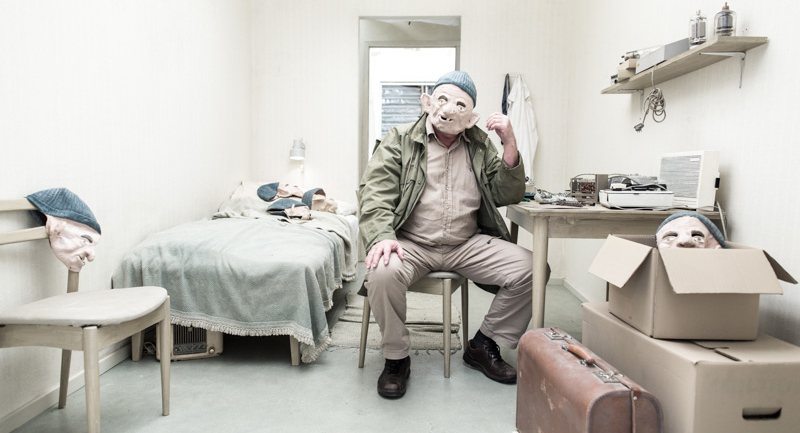A PIGEON SAT ON A BRANCH REFLECTING ON EXISTENCE
Magnolia Pictures
Reviewed by: Harvey Karten for Shockya. Databased on Rotten Tomatoes.
Grade: C+
Director: Roy Andersson
Screenwriter: Roy Andersson
Cast: Holger Andersson, Nila Westblom, Charlotta Larsson, Viktor Gyllenberg, Lotti Tornros, Jonas Gerholdm, Ola Stensson, Oscar Salaomonsson, Roger Olsen Likvern
Screened at: Review 2, NYC, 4/22/15
Opens: June 3, 2015
A guy sees his friend writhing on the ground with a spear implanted in his stomach. “Are you OK?” the guy queries using that hoary cliché so prominent in the movies and on TV. “It hurts only when I laugh,” the friend responds. As absurdist as the answer sounds, there is a philosophic truth therein. Life is good even it’s bad, which is probably why people who suffer from horrible paralytic afflictions like Lou Gehrig’s disease generally want to live.
“Life is good even when it’s bad” forms the theme of the third movie of Roy Andersson’s trilogy on the human condition, Roy Andersson, in what some critics have called more accessible than his “Songs from the Second Floor” and “You the Living,” offers us “A Pigeon Sat on a Branch Reflecting on Existence,” which he says was partially motivated by a Renaissance painting by Bruegel the Elder, “Hunters in the Snow.” Bruegel is celebrated for his detailed landscapes, in this case featuring four birds observing the human beings below, their follies and contradictions and absurdities.
“Pigeon” is composed of thirty-nine vignettes, all of which are as deadpan as you are likely to see with the possible exception of the comedy “Welcome to Me.” The scenes are cohesive only when two salesmen are on the screen: Sam (Nils Westblom) and Jonathan (Holger Andersson), who operate in the style of Quixote and Sancho Panza, or Samuel Beckett’s Dido and Gogo, or even Laurel and Hardy. But unlike the last pair, they never engage in slapstick humor, relating to each other and to others in the vignettes as though appearing in one of those inscrutable cartoons in The New Yorker magazine—which prominently feature jokes about death. Yes, there is humor in dying, the best example of which can be found in one of Roy Andersson’s early scenes in which a woman lies on her deathbed, her face exuding all the pallor of the mortally ill (as are other faces in the film), but she is clutching her handbag. A family member keeping vigil explains that she wants to take the handbag with her to heaven, and sure enough, when one fellow tries gently to pry the object from her fingers, the poor woman moans and clings to her property.
From there the action becomes more lively, but only somewhat. For example, a follow-up to that death scene finds us watching a cruise ship. A passenger drops dead, but the crew are more concerned about the meal he had just purchased, offering those still living a free glass of beer and a plate of food. “He paid for it,” is about the best memorial they could think of for the fellow.
In the most serious allegorical content but, again, one that shows humor in defeat, an exhausted King Charles XII (late 17th century) at first enters a café to find a bathroom (which is occupied and therefore off limits—never mind that there were no bathrooms in Charlie’s day) and is followed up by troupes of Swedish fighters trudging home after losing half their country. If you look outside you’ll see the soldiers, each with a hand on the shoulder of the man in front of him, reminiscent of Bruegel’s painting “The Blind Leading the Blind.” Women cry, not necessarily because of the Swedish losses but more likely due to incidents of their own sad lives.
Give this to the writer-director. Each of the scenes is carefully composed. The actors comport themselves in line with the probable direction, holding themselves back from laughing out loud at the absurdity of its all. And the two salesmen, who are peddling useless party novelties like vampire fangs and rubber masks showing one tooth, carry on with their trade as though they were really adults engaging in a responsible job.
In other words, to get back to the initial point, life is good even when it is absurd, and death itself is not a condition to be mourned but rather to get over quickly to allow the living to get back to carrying out their daily tasks. But admire though one may the composition of the scenes, the comic pacing, the actors who carry out the banalities of their existence as though to say “I don’t know why I am doing this, but life is still good,” audience members could not be blamed for feeling exasperated by the lack of cohesion among most of the scenes and the slow-motion actions depicted herein. Yet the film has already received critical accolades and awards at festival as in Venice, though one can imagine many audience members heading to something like “Batman v Superman” to get back to something more realistic.
Unrated. 101 minutes. © Harvey Karten, Member, NY Film Critics Online
Story – C
Acting – B
Technical – B
Overall – C+
Unrated. 101 minutes. © Harvey Karten, Member, New York Film Critics Online

